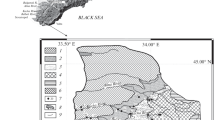Abstract—
The formation conditions of the Bishuli thermomineral waters from the Crimean Plain were determined by a complex of isotopic methods. The absence of tritium (3H < 0.1 TU) and considerable radiocarbon age (τ = 28 ± 3 ka) are in line with the light isotopic composition of the mineral water (δ18O = –13.4‰ and δ2H = –96‰), which is strongly different from that of the recent precipitation, river water, and groundwater of the region (δ18O from –7.4 to –8.7‰ and δ2H from –50 to –62‰). The formation of the mineral waters should be assigned to the Dnestr pluvial interstadial of the last glaciation, which reached the maximum in the region approximately 27 ka ago. The recharge zone is probably located on the northern slope of the Crimean Mountains (at a distance of ~60 km), which, together with the absence of tritium, indicates that the mineral waters are protected from an anthropogenic impact.


Similar content being viewed by others
REFERENCES
S. V. Al’bov, “Carbonic mineral springs of Crimea,” Sb. Krymsk. Fil. Akad. Nauk SSSR, No. 5, 11–41 (1954).
S. V. Al’bov, “Oldest tapping of mineral carbonic water in the USSR,” Izv. KO GO SSSR, Otd. Vyp., 43–44 (1958).
S. V. Al’bov, “On relation of trace components in carbonic and mud volcano waters in the iron ore deposits of the Kerch Peninsula,” Dokl. Akad. Nauk SSSR 175 (5), 711–714 (1967).
S. V. Al’bov, Healthful Springs of Crimea. A Brief Handbook (Tavriya, Simferopol, 1991) [in Russian]. Balneotherapy Decision on the Mineral Water from Well No. 38-D. s. Pyatikhatka, Krasnogvardeisk Area (Mineral Natural Potable Medical Water “Bishuli), Republic Crimea (RNTs MRiK Minzdrav Rossii, 2014). http://www.bishuli.ru/docs/Бальнеологическое%20 заключение.pdf [in Russian].
P. U. Clark, A. S. Dyke, J. D. Shakun, A. E. Carlson, J. Clark, B. Wohlfarth, J. X. Mitrovica, S. W. Hostetler, and A. M. McCabe, “The last glacial maximum,” Science 325 (5941), (2009).
Yu. V. Dublyansky, A. B. Klimchouk, S. V. Tokarev, G. N. Amelichev, L. Langhamer, and C. Spötl, “Stable isotopic composition of atmospheric precipitation on the Crimean Peninsula and its controlling factors,” J. Hydrol. (565), 61–73 (2018).
V. V. Ferronsky, and V. A. Polyakov, Isotopy of Hydrosphere (Nauka, Moscow, 2009) [in Russian]. Geology of the USSR. Volume 8. Crimea. Mineral Resources, Ed. by A. V. Sidorenko (Nedra, Moscow, 1974) [in Russian].
N. Gerasimenko, “Environmental changes in the Crimean mountains during the Last Interglacial–Middle Pleniglacial as recorded by pollen and lithopedology,” Quatern. Int. 164–165, 207–220 (2007).
N. P. Gerasimenko, and Zh. M. Matviishina, “Staged evolution of the natural environment of Ukraine in the Late Pleistocene,” Fiz. Geogr. Geomorph. 53, 13–26 (2007).
Hydrogeology of the USSR.Volume 8.Crimea, Ed. by V. G. Tkachuk (Nedra, Moscow, 1970) [in Russian].
V. V. Ivanov, and G. A. Nevraev, Classification of Groundwaters (Nedra, Moscow, 1964) [in Russian].
A. S. Kaisinova, A. N. Glukhov, S. R. Danilov, and F. I. Tekeeva, “Chemical composition and properties of the Bishuli mineral waters (Pyatikhatka village, Krasnogvardeisk area, Crimear Republic) and possibilities of its use in balneological purposes,” Kurortnaya Meditsina 4, 13–17 (2016).
M. V. Kokhanovich, Mineral Waters of Crimea (Simferopol, 1964) [in Russian].
L. E. Lisiecky and M. E. Raymo, “A Pliocene–Pleistocene stack of 57 globally distributed benthic δ18O records,” Paleoceanography 20 (1), (2005).
F. P. Samsonov, “Artesian waters of Lower Cretaceous sediments of the Crimea,” Izv. Vyssh. Ucheb. Zaved. Geol. Razvedka, No. 2, 105–117 (1961).
Funding
This study was financially supported by the Russian Foundation for Basic Research and the Council of Ministers of the Crimean Republic, project nos. 16-45-910579 r_a and 18-45-910007 r_a.
Author information
Authors and Affiliations
Corresponding authors
Additional information
Translated by A. Girnis
Rights and permissions
About this article
Cite this article
Amelichev, G.N., Tokarev, I.V. & Tokarev, S.V. Estimation of the Formation Conditions of the Bishuli Thermomineral Water (Crimean Plain) by Isotope Geochemical Methods. Geochem. Int. 57, 1355–1359 (2019). https://doi.org/10.1134/S0016702919120036
Received:
Revised:
Accepted:
Published:
Issue Date:
DOI: https://doi.org/10.1134/S0016702919120036




